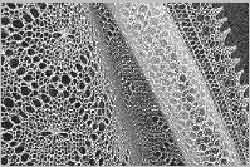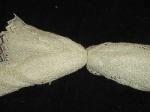Orenburg Shawls
The first mentions about Orenburg shawls date as far as 17-th century. Russians that settled in Ural Mountain area felt necessity in warm clothing made of goat down to stand severe winters. The famous Orenburg woven shawls are made entirely by hand. They are handspuned and hand knitted from the finest down of goats in the region of Orenburg near Ural Mountains.
The shawls have natural colors of the goats and can be white, gray or brown. Prices depend on size, on quality of threads used for making of the shawls and, of course, on quality of work. Each woman makes her own shawls with her own lacy ornaments and patterns of the shawl. The softer and finer the fiber is, the more valuable is the shawl. In Russia with cold and long winters women used to wear these shawl everyday especially in country area. Each woman has at least two shawls - one for everyday usage and other one for holidays. Shawls used for everyday often are plied with silk for strength so that they can withstand daily use.
Many people ask what kind of material (wool) is used fro knitting of the Orenburg shawls. Authentic Orenburg shawls are made of goat down. Sometimes people by mistake call the down "cashmere" but this is not exactly so. People in Orenburg area breed species of goats that give not only milk but perfect soft and light down. These goats are quite fastidious for food and for conditions of living. Once during a year a goat bears one goat baby, seldom 2 or even 3. In the beginning of winter when down gets enough long and with enough quality women comb the goats. This is hard work as it down fibers should be comb separately. In average one goat brings about 2 LB of down. Then the down is washed, is sorted and later is spinned for further knotting. 
This image shows how a shawl can be stretched through a wedding ring
Goat down shawls are durable in usage, the more shawl is used the more attractive it is. Of course, it is necessary to follow some simple rules that help to keep a shawl in good condition. It is advised to use dry cleaning. At a pinch it can be washed in not hot water using washing powder for wool. Alternatively, it can be washed in warm sudsy water.
Do not twist a shawl and always dry flat, away from heat. This simple rules will make your Orenburg shawl a real family heirloom
Once I received a letter from my customer from England who recently bought a couple of Orenburg shawls. Here is what she wrote:
The Russian shawls are so much more attractive than the pashmina shawls which are sold all over Europe at very expensive prices.
Russian Orenburg shawls are really hand-made, they are produced in limited amount and each shawl is different and unique.
Manufacturing process of Orenburg shawls production at Orenburg shawl factory
Orenburg goat down shawls are unique products and they demand unique equipment, unique technological process and high skill of workers. In past Orenburg shawls were handspun and hand knitted, a shaw-maker should spend about 2 weeks to weave a quality shawl not counting efforts and time spent for preparing yarn and threads. In the end quality of a ready shawl greatly depended on qualification of a weaver and its price was so higher that not many women could afford to wear beautiful shawls.
The Orenburg Shawl Factory was established in 1960 in order provide growing demand for high quality goat down shawls for affording price. More than 30 small work-shops were organized into large enterprise. Many years were spent to organize manufacturing process, to develop, produce and tune unique machines and equipment and to gain a priceless experience.
Manufacturing of Orenburg shawls at the factory is the full cycle process beginning from gathering raw goat down and wool and ending of production of goods and utilization of scrap. The process can be divided into three stages:
1. Preparation of raw material for production of yarn;
2. Production of yarn
3. Knitting of goods.
Preparation of raw material for production of yarn
The factory purchases only high quality raw materials that provide certain requests and that are put to the tests in factory laboratory.
First of all all raw materials (down and wool) pass sorting. This is routing process is made by hand, during it workers sort materials in accordance with fiber length, color and clearness.
Each sort of down and wool is intended for production of specific yarn. As any other technological process it put to the laboratory tests.
Depending on sort the raw materials pass from 3 to 7 stages of treatment.
First of all the raw materials are made light, then they are moved to washing machines where they are washed and dried in special air chamber under high pressure. Washing machines are unique equipment made on special order.
Then the dried raw materials are sorted again for making more quality components of yarn. Rough hairs and dust are removed at this stage. In the end clean high quality raw materials are ready for yarn making process.
Production of yarn
In general the process of yarn production consists of 4-5 stages. First of all yarn components are put to special oil mixing machine for mixing and making them soft and elastic. Softening emulsion has a secret recipe and it is factory “now-how”. Then a roving thread is produced, then - a single thread. Then a single thread is spliced with additional thread to gain durability and strength. Then the yarn is spinned into bobbins.
Production of ready goods
The main part of Orenburg shawls, scarves, tippets, cobwebs are knitted by hand, only most labour-intensive and routine operation are made by machines. It allows knitters to concentrate only on creative operation of shawl knitting. The fact that some operations are machine made does not degrade quality of shawls and specific features of real hand-made Orenburg shawls but makes these items more perfect.
After knitting goods (shawls, scarves, tippets, cobwebs) are passed to coloring and finishing shop where they are cleaned, blanched, ironed, dyed and dried. All these processes are made with using on special equipments that were developed and made on special orders.
After full manufacturing process goods are put to the tests and passed to the store house. All goods conform to state and local standards
